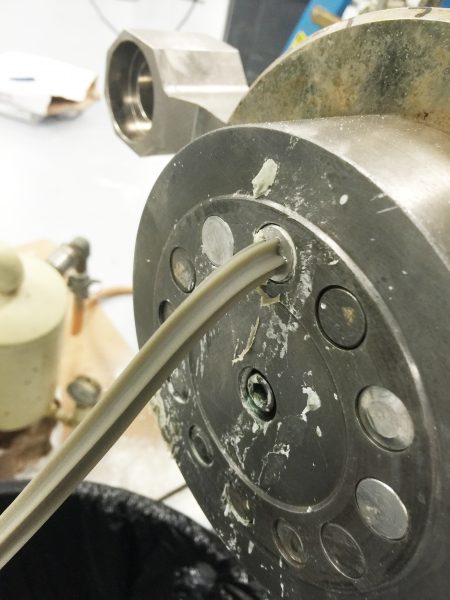From fish waste to Fido snacks
July 7, 2017
Carol Kaynor
(907) 474-7086
Chris Sannito’s dog Sammy is really happy that his owner has developed a tasty pet
treat made out of pollock skins. Informal taste tests by Sammy and other Kodiak canines
indicate the treats — although not fishy smelling to humans — have plenty of that
deep-sea essence dogs love so much.

Sannito is an Alaska Sea Grant seafood technology specialist based at the Kodiak Seafood and Marine Science Center. Just prior to his hire in March 2015, Sannito started working with faculty at the University of Alaska Fairbanks on a research grant from the Pollock Conservation Cooperative Research Center. The task was to determine whether pollock skins could be turned into a product that was tasty to dogs, easy for humans to handle and shelf-stable for at least six months.
The project excited Sannito because he saw a lot of flexibility in how he could develop the treats. But initial attempts to dry the pollock skins were labor- and energy-intensive and didn’t seem like a good bet for a commercial product.
Sannito wondered what other methods might be effective. From his graduate school days, he remembered a researcher interested in food extrusion technology. The researcher had used a Clextral extruder — a machine designed to push material through a barrel with a screw — to create a snack made of rice flour and fish powder, with added flavorings.
“So I was always curious about extruders,” Sannito said. He learned that pet-treat manufacturers, such as Purina, use extruders to make all kinds of products. “Why couldn’t we incorporate fish skins into the extrusion process?” he asked.
Sannito took 500 pounds of fish skins to Tampa, Florida, for a one-day trial in the Clextral pilot plant. With a little bit of experimenting, the extruder produced a semisoft product with very little odor that was high in collagen protein. The product had a consistency similar to licorice and could be formed into myriad shapes. Since dogs don’t purchase their own treats, Sannito said, it was important to produce something that was easy to handle and not too smelly to humans.
The Clextral plant runs all sorts of materials through its extruder, but the fish skins were a novelty for the plant technicians, who took some home for their own dogs. Back in Kodiak, unofficial taste tests on local dogs showed that the fish skin treats were a hit. Sannito said that his own dog is probably one of the biggest supporters, but he has other fans as well.
“Every day, Sable coworker’s dog comes to my door looking for pet treats.” Formal pet trials would require lots of paperwork, but Sannito has been handing out the treats informally and said, “We have yet to find a dog that would turn them down.”
On May 5, Sannito and Quentin Fong, Alaska Sea Grant’s seafood marketing specialist, received the 2017 Invent Alaska award for “innovation in research leading to commercialization” from the UAF Office of Intellectual Property and Commercialization. The next step is to find industry partners to develop a commercialized product. The UAF intellectual property office is very interested and may help in the search for partners, according to Sannito.

Although the payoff to fish processors could be significant, there are costs involved in pulling out skins for further processing. Some processors simply grind and discharge their waste at sea. But where communities have processing plants, truckloads of skins are turned into fishmeal. Pet treats are a higher-value commodity, and more and more processors are seeing the opportunities in that type of product.
“The neat thing is the form that you can produce off an extruder,” Sannito said. “The sky is the limit, depending on which shaped die you choose, so you could pump out little goldfish or licorice sticks or flat bars. And that gives you so much creativity. You could color it any way you wanted with food coloring. It’s a neat canvas of opportunity.” That’s where marketing will come in, finding consumer-friendly forms to take advantage of a constant stream of fish waste. “Think of all the skinless fish products that are sold in Alaska,” Sannito said.
For now, pollock-skin goldfish treats are not yet available at the local pet store, so Sable will have to keep visiting Sannito for her daily snack.
Read more about the project in this Alaska Journal of Commerce story.


